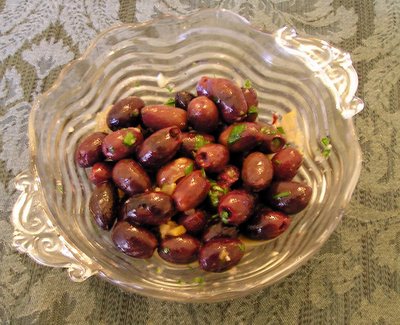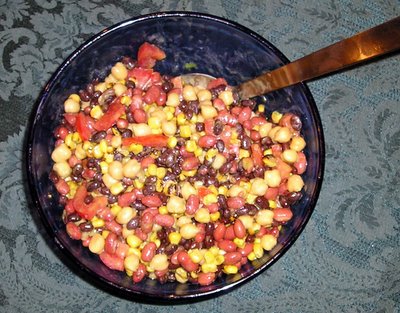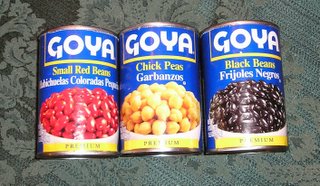Red-headed Stepchild of Something from Nothing

When I accepted the Something out of Nothing challenge (it sounds like something out of a laundry detergent commercial, doesn't it?), I was determined to make an entire meal, something you would not be embarrassed to serve to three other people of whom you were reasonably fond, for a small amount of money. I posted most of the main course the other day. Since I had purchased a head of garlic to use in both the grits and the black beans, and since green beans were on sale for less than a buck a pound, I was going to round out the main course with green beans made the way I like them: boiled, shocked in cold water, then reheated in a skillet with a splash of olive oil, a minced clove of garlic, and perhaps a half-teaspoon of finely grated ginger. I didn't have time to actually do any of that, of course, but it's a fine way to notionally finish off the plate.
My original idea for dessert was to take peel, core, and thickly slice a few apples, saute them briefly in a couple of tablespoons of butter, then add the juice and zest of one or two blood oranges, and continue to cook until the apples were tender and glazed. I was going to serve that on top of a sweetened yogurt cheese.
It sounds like a pretty good plan to me, and I may have to try it sometime. But at some point during the week, I was having my dinner (which probably means that it was after 10 pm, and V. had reheated something for me), and I reached for the loaf of something that was labeled French bread and which is not something that you'd ever mistake for a Parisian baguette but which nonetheless is usually pretty competent, especially when compared to what you used to get ten years ago when you bought something labeled French bread at the supermarket, and V. told me to slice some whole wheat bread instead because the French bread had dried out because they were only selling it in two packs the day he bought it, so the second loaf had gone a bit stale before he got to it.
And, really, if your partner telling you that the bread is stale isn't the hand of Providence, what is? It was immediately obvious to me that the universe was telling me that it was time to once and for all (no, not split that infinitive; we all know I know how to do that) subdue my bread pudding bogeyman.
Before this week, I had not, in fact, made bread pudding for many years. When I lived in Boston, my roommate R. and I would (very) occasionally go to a restaurant called Saffi's, which was subtitled New Orleans North. It was somewhat beyond our severely limited budgets, but every once in a great while, you need to splurge, and they made a pear-glazed duck that was preternaturally delicious (I'll take discarded Lucky Charms mottoes for $400, Alex!) and a Bourbon bread pudding that was even better. At the time, I tried a couple of times to make my own version of bread pudding, but the results were uniformly disappointing (by which, you understand, I mean that the disappointment was uniform, not that they were disappointing in exactly the same way; I like to think that my failures are as eclectic as anyone's, thanks), and I soon gave up.
Years later, I was watching the Food Network, and someone mentioned that when you make bread pudding, you have to be sure to let the bread soak in the custard mixture for a good while so that it will get thoroughly saturated. Typical: I get the memo, but fifteen years too late. Anyway, ever since I heard that, the notion that I really needed to try again with bread pudding had been wandering about in the far reaches of my fragmented psyche, and when I was presented with the bread, I had only to come up with the pudding. Of course, I still had the apples and the blood oranges and the yogurt, so I decided to incorporate them.
I wrote the recipe in a different format than usual, so to be kind, I'll list the ingredients up front.
6 cups cubed dried bread
1 orange, blood if available
4 T. butter, melted
1 large baking apple
1/3 nutmeg, grated
1/4 tsp. ground cardamom or seven cardamom pods
2 cups milk
2/3 cup sugar
4 eggs
2 cups yogurt
2-3 T. honey
Bread Pudding
Take a stale loaf of bread, preferably something that was once a reasonable approximation of a baguette or a batard, something that was once proud but is now embarrassed to find itself in reduced circumstances, something that has all but lost hope.
With as much kindness as you can muster, slice, dice, and/or crumble the bread into smallish pieces. Assure it that its sacrifice will not be in vain. Place the bread in a bowl. You should have about six cups.
Grab a large and lusty blood orange and remove its zest. Put the zest in with the bread. Set the orange aside. Wrap it in plastic if necessary. You will need to take its juice later.
Take a whole nutmeg and grate about a third of it over the bread mixture.
Melt three or four tablespoons of butter. Pour it over the bread and mix reasonably well.
Peel, core, and chop into large dice a good baking apple. Add it to the bowl.
If you are sure that you will be feeding the pudding to the sort of people who do not automatically object at the sight of currants, add a few tablespoons of them now. Also, count your blessings.
In a blender, combine two cups of milk, four eggs, two-thirds of a cup of granulated sugar, and the contents of seven pods of cardamom. Blend until the cardamom is well ground.
Pour the egg mixture over the bread mixture. Stir well, cover, and refrigerate for at least an hour, or overnight.
Start your sauce. Directions follow the end of the pudding recipe.
When it's time to bake the pudding, preheat the oven to 350 degrees. Butter a nine-by-nine baking dish and pack the pudding mixture into it. Bake until a knife inserted near the center comes out clean and it is nicely browned on the top and crusty around the sides of the pan. This will take nearly an hour, especially if you're baking the pudding right out of the refrigerator. You really don't want to underbake this pudding. You don't want to overbake it either, obviously, but I don't think there's much danger of that unless you go on vacation while it's in the oven.
 Let the pudding cool for at least fifteen minutes. It's best warm, but you can serve it cool or you can refrigerate it and reheat it, but it's better to just refrigerate the unbaked pudding and bake it just before you're going to want to serve it. Scoop a generous portion of it into a bowl and top with a generous portion of the blood orange yogurt sauce, which you will have completed while the bread pudding was in the oven.
Let the pudding cool for at least fifteen minutes. It's best warm, but you can serve it cool or you can refrigerate it and reheat it, but it's better to just refrigerate the unbaked pudding and bake it just before you're going to want to serve it. Scoop a generous portion of it into a bowl and top with a generous portion of the blood orange yogurt sauce, which you will have completed while the bread pudding was in the oven. Blood Orange Yogurt Sauce
Line a strainer with paper towels or a coffee filter. Put two cups of yogurt (whole milk yogurt would be best, but lowfat yogurt is okay) in the lined strainer, suspend the strainer over a bowl, and refrigerate overnight. (Pour off the extra liquid unless you have some good use for it. I don't know what that would be, but I'm sure you know what you're doing.)
Put the resulting yogurt cheese in a mixing bowl. Cut your blood orange in half, juice it, and add the juice to the yogurt cheese. Stir well to combine. Add about two tablespoons of honey, and stir that in well. Taste the sauce, and if it needs another tablespoon of honey, add it. Don't go overboard with the honey. You want it to balance the tanginess of the yogurt, not eliminate it.
I only used the blender to make the custard mixture because of the cardamom. I had not intended to put cardamom in the pudding, but my whole nutmegs are stored in a bag inside a container that also contains a bag containing my whole cardamom pods, and when I opened the container, the smell of the cardamom enticed me and would not be denied. There's a reason they call it the queen of spices. If you use ground cardamom instead or if you can grind your own small quantities with a mortar and pestle, you can just add the cardamom to the other dry ingredients and mix up the eggs, milk, and sugar with a whisk.
I am not sure that the bread pudding I made was really the bread pudding I've been dreaming of all these years. Don't get me wrong: if you serve this to anyone, he or she will be very happy, and it's miles ahead of where my first, long-ago forays into the bread pudding universe were, and I'm pretty happy with it. But mine could, perhaps, have used a bit more time in the oven. It also could have used slightly more butter, but I already compensated for that shortage when I wrote up the recipe. It maybe could have used another cup of bread or a bread that was a bit more substantial to begin with, but I'm not really sure about that, and, in any case, I'm quibbling. It was yummy.
The sauce, on the other hand, requires no improvement whatsoever. It is so simple and so good that I really can't think how I ever got along without it, and it goes splendidly with the bread pudding. I suspect, though I didn't test the hypothesis, that if there are no blood oranges available, you can get a very nice sauce with a regular orange. And you can use it on all sorts of other things. Like maybe some nice sauteed apples.















